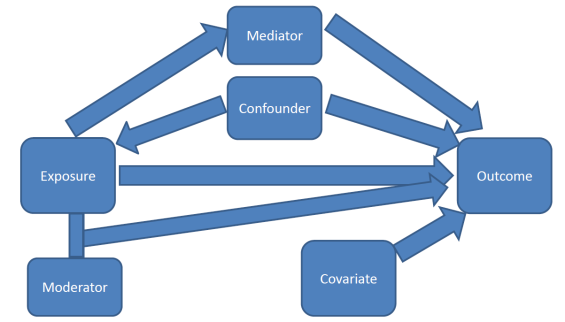9.6 Confounding
One primary purpose of a multivariable model is to assess the relationship between a particular explanatory variable \(x\) and your response variable \(y\), after controlling for other factors.

Credit: A blog about statistical musings
Other factors (characteristics/variables) could also be explaining part of the variability seen in \(y\).
If the relationship between \(x_{1}\) and \(y\) is bivariately significant, but then no longer significant once \(x_{2}\) has been added to the model, then \(x_{2}\) is said to explain, or confound, the relationship between \(x_{1}\) and \(y\).
Steps to determine if a variable \(x_{2}\) is a confounder.
- Fit a regression model on \(y \sim x_{1}\).
- If \(x_{1}\) is not significantly associated with \(y\), STOP. Re-read the “IF” part of the definition of a confounder.
- Fit a regression model on \(y \sim x_{1} + x_{2}\).
- Look at the p-value for \(x_{1}\). One of two things will have happened.
- If \(x_{1}\) is still significant, then \(x_{2}\) does NOT confound (or explain) the relationship between \(y\) and \(x_{1}\).
- If \(x_{1}\) is NO LONGER significantly associated with \(y\), then \(x_{2}\) IS a confounder.
This means that the third variable is explaining the relationship between the explanatory variable and the response variable.
Note that this is a two way relationship. The order of \(x_{1}\) and \(x_{2}\) is invaraiant. If you were to add \(x_{2}\) to the model before \(x_{1}\) you may see the same thing occur. That is - both variables are explaining the same portion of the variance in \(y\).